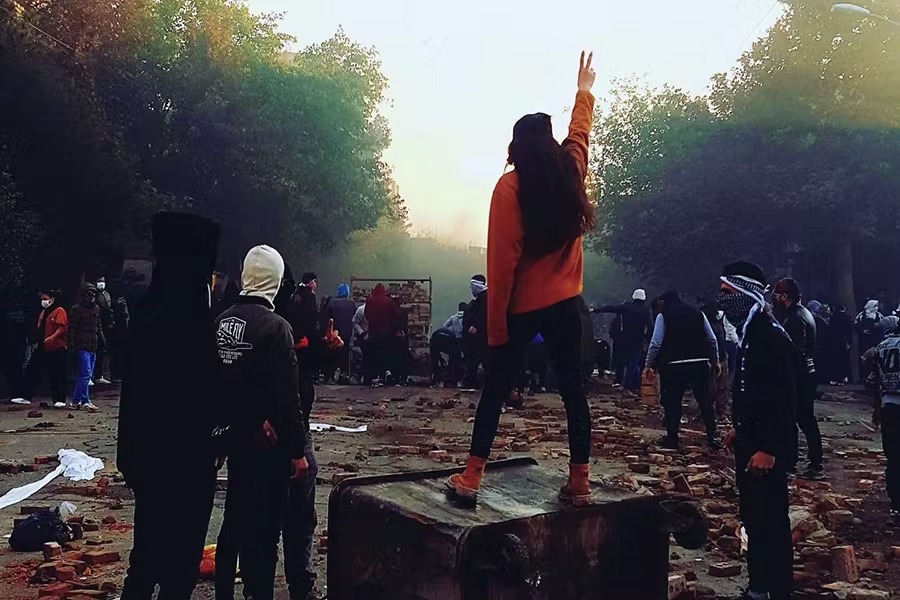The slogan “Woman, Life, Freedom” represents a political movement that emerged in Iran with significant implications for the entire Middle East. It was a progressive and radical moment in recent regional history. However, it cannot be understood in isolation. It must be seen as part of a broader process of civil resistance and political mobilization that has developed over at least two decades across the region.
The foundations of this movement lie in long-standing struggles against dictatorship, state-imposed religion and nationalism. These are not uniquely Iranian problems. They have shaped the political systems of most Middle Eastern states and are central obstacles to any emancipatory politics in the region.
Shifting Power from Below
The widespread protests of recent years—beginning with the mass uprisings of December 2017, November 2019, and culminating in September 2022—have fundamentally altered the political atmosphere in Iran. These movements have shifted the balance of power between the state and society, tipping it in favor of the oppressed and those demanding freedom.
This shift has forced the Islamic Republic to retreat on several social fronts. Issues such as women’s rights, particularly the rejection of compulsory veiling, as well as the right to joy, music, and dance, have been imposed on the regime by society itself. The state’s efforts to maintain an atmosphere of mourning and misogyny have increasingly failed in the face of public defiance.
In response to growing fears of new social explosions, the regime has been compelled to ease some cultural restrictions. Over the past few years, state-sponsored Newroz and New Year celebrations—including public gatherings, music, and dancing—reflect the authorities’ reluctant retreat in the face of popular pressure. In 2024, fearing that public Nowruz celebrations might turn into anti-government protests, the regime sought to control the festivities by organizing official events and designating specific public spaces for managed celebrations. In an unusual move, it even sidelined religious commemorations such as Laylat al-Qadr and the anniversary of Imam Ali’s injury to make space for public festivities.
Yet, people who have already witnessed the regime’s retreat and fear have not limited themselves to these official frameworks. Instead, they have used these state-sanctioned events as opportunities for mass gatherings, joyful celebrations, dancing, and music, turning the occasion into a show of collective will and popular culture.
In Urmia, the Nowruz celebration on the first day of spring saw large participation, especially among the city’s Kurdish population. The event was marked by fire-lighting, dancing, and festive public gatherings, reflecting both the cultural resilience of the people and their refusal to surrender public space to state control.
ارومیه رکورد شکست!
— Omid Barin | امید برین (@barin_omid) March 18, 2025
به گفته حاضران و منابع محلی شمار شرکتکنندگان در مراسم #نوروز ارومیه رقم صدهزار نفر را رد کرده است. تصویر زیر تنها بخش کوچکی از میدان نوروز و شمار حاضران را نشان میدهد. شمار حاضران کماکان در حال افزایش است.
کارزان #ایلام رکورد #ارومیه را میشکند؟#Newroz2025 pic.twitter.com/vCvL33lTTI
#اروميه #كوردستان جشن نوروز کوردهای این شهر pic.twitter.com/SoOlWsheTG
— Tahir Ghasemi (@TaQasemi) March 18, 2025
Nowruz celebration with nearly 100,000 people in Urmia
Zionism and Political Islam
At the center of civil and political struggle in the Middle East is the issue of Palestine. This issue mobilizes both religious and nationalism forces, although in different ways. On the religious side, various reactionary and authoritarian currents try to frame Palestine through a theological lens, often drawing on traditional anti-Jewish narratives. On the nationalism side, some ethnic-nationalist forces try to remove religion from the equation entirely and present themselves as the legitimate political alternative. In the post-colonial period, the most prominent secular response was Pan-Arabism, which challenged Zionism politically and militarily but ultimately failed to achieve its goals. Its influence declined further with the rise of political Islam.
Political Islam, however, does not represent a continuation of anti-colonial resistance. It is a different phenomenon. It has become one of the main instruments of reaction in the region. In practical terms, Zionism and political Islam now function as complementary forces. They each justify their existence through the threat of the other. Both rely on militarism, war, and authoritarian rule to survive.
The “Woman, Life, Freedom” movement posed a direct threat to both of these reactionary systems. Its central demands—democratic rights, secular governance, and gender equality—challenge the ideological and structural foundations of both Zionism and political Islam. Weakening one of these systems destabilizes the other, as both draw strength from the ongoing repression and fragmentation of the region.
«قشقایی؛ تورکمن؛ اتحاد اتحاد»
— Araz News (@ArazNews_org) March 22, 2025
پیام اتحاد و همبستگی ملت تورک آزربایجان به تورکهای قشقایی و تورکمن
امروز؛ اجتماع عظیم ضد تروریستی مردم اورمیه pic.twitter.com/EpuxvSuxy6
امروز تمام ملت تورک از مذهبی و غیر مذهبی گرفته تا مخالف و موافق حاکمیت همه یکپارچه در صحنه بودند تا به زیاده خواهان نشان دهند «تورپاقدان پای اولماز» pic.twitter.com/2uO2yO7ShY
— Araz News (@ArazNews_org) March 22, 2025
A state-sponsored ceremony was held in Urmia with the participation of thugs and members of the fascist organization Grey Wolves, targeting the city’s cultural and ethnic diversity. The presence of government officials and IRGC forces was clearly visible. Images from the far-right Araz News.
In this context, recent events in Urmia, a city in northwestern Iran with a mixed population of Kurds, Turks, Armenians, Alawites, and Assyrians, are worth noting. During the Nowruz celebrations, a group closely tied to the IRGC mobilized to disrupt the events. They were chanting slogans like, “Urmia will not become Kurdistan!” This group is led by a former member of parliament known for his hardline pan-Turkist views and links to the Grey Wolves, a Turkish fascist ideology. This was not simply a local cultural dispute. It was an example of organized reaction, aimed at deepening ethnic divisions and asserting state-backed ethnic nationalism.
The fascist march in Urmia was not limited to cultural provocation. Participants went further by invoking the name of one of the most brutal Islamic figures from the early 1980s, openly calling for the execution of their opponents and critics, specially leftist and kurds. This reference was not accidental—it was a clear message aimed at reviving the atmosphere of terror and repression associated with the early years of the Islamic regime.
At the same time, we can observe a political convergence between elements of the Islamic regime and parts of the exiled monarchist opposition. Both rely on ethnic and religious polarization as a political strategy. In recent years, monarchist groups have become increasingly radical, with open support from Israel and alignment with pan-Iranist ideologies. On Nowruz, in Mashhad, a group associated with this camp chanted the slogan: “We are Aryans, we don’t worship Arabs.” This marks a clear shift toward racial nationalism.
Israel, for its part, is actively pursuing a strategy to weaken Iran by promoting sectarian and ethnic divisions. Certain factions within both the Islamic regime and the monarchist camp appear to be following this path—either deliberately or indirectly. They believe that fragmenting Iran along ethnic or religious lines can help suppress the revolutionary movement and prepare the ground for a coup-like scenario to gain political power.
While this scenario is plausible, it also highlights a crucial point: Israel stands to benefit the most from the collapse of revolutionary cohesion in Iran. At the same time, Israel’s broader objective goes further—the eventual disintegration of Iran as a unified state.
From the regional perspective, the question of Palestine remains central in this entire political landscape. A democratic and left-wing revolution in Iran would pose a direct threat to Zionist policy. It would weaken both the ideological legitimacy and the military strategy of the Israeli state. Such a revolution would not only transform Iran—it would have regional consequences, including within Israel itself. It would challenge the continuation of settler colonialism in Palestine and force a reorganization of power in the Middle East.
«ما آریایی هستیم عرب نمی پرستیم». pic.twitter.com/4jet2gWwOJ
— اتاق خبر منوتو (@ManotoNews) March 20, 2025
During the Nowruz celebrations in Mashhad, a group of people affiliated with monarchist and pan-Iranist circles gathered near the tomb of Ferdowsi and chanted the slogan: “We are Aryans, we don’t worship Arabs.” This slogan, openly racist signals reflects the increasing influence of racial nationalism within anti-regime protests that were dominated by democratic and inclusive demands.
According to reports, the event was not spontaneous. It was organized and promoted on social media by nationalist networks, some of which openly advocate for ethnic purity and the revival of a pre-Islamic, ethnically exclusive Iranian identity. These groups often combine admiration for the Pahlavi monarchy with hostility toward Arabs, Kurds, and religious minorities, and their slogans aim to rewrite the meaning of protest around ideas of national superiority.
Images from the far-right TV station “MANOTO”
This is precisely the scenario that Netanyahu seeks to avoid at all costs. On the other hand, even figures like Trump have at times entertained the idea of an Islamic Republic that poses less of a threat to Israel—a regime that remains authoritarian but more predictable.
What makes this situation particularly significant is that Israel, more than many Western states or even the United States, has a sharper and more realistic understanding of Iranian society. Israeli officials know that this society is neither religious nor motivated by ethnic or nationalist ideologies. In the past twenty years of protest movements in Iran, there has been no evidence of such ideologies playing a central role.
But now, these ideas are being reintroduced—by monarchists, who are attempting to shape the revolutionary movement around nationalist slogans. In parallel, the IRGC is escalating repression. While the there goal is suppression, the monarchists aim to divert the revolution entirely and welcoming part of the IRGC to align with their pan-Iranist project. For parts of the West, this might appear as a manageable scenario—but Israel rejects even this possibility.



In the spring of 2023, Reza Pahlavi met with Benjamin Netanyahu, signaling a clearer alignment between sections of the monarchist opposition and the Israeli government. His wife, Yasmin Pahlavi, is known for her hardline positions. During protests abroad, she has been heard promoting slogans that include calls for the execution of progressive and leftist forces, further exposing the authoritarian tendencies within this current. Meanwhile, Farah Pahlavi, the former queen, continues to advocate for political alignment with Israel—a position she has consistently maintained.
The struggle in Iran, therefore, cannot be separated from the broader regional and global context. It is not simply a national uprising. It is a part of the ongoing confrontation between reactionary forces—Zionism, political Islam, militarized nationalism—and the forces of democratic and social emancipation. Understanding this relationship is essential for anyone who wants to develop a serious political strategy in the region.
Various opposition forces—from those advocating a return to the constitutional monarchy, to republicans, democrats, and different leftist and communist tendencies—have condemned the recent events. They have emphasized the importance of preserving national unity and maintaining a revolutionary outlook.
Iran is entering a turbulent and significant period—one that may go beyond our current expectations.






What you think?